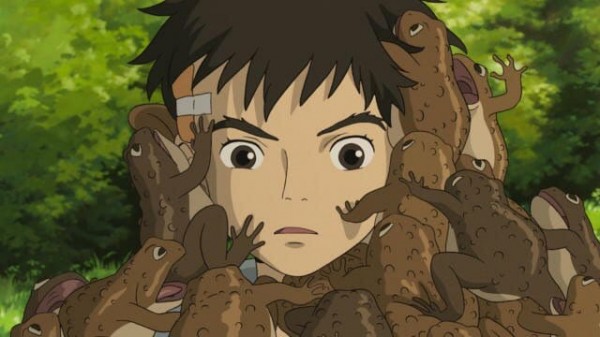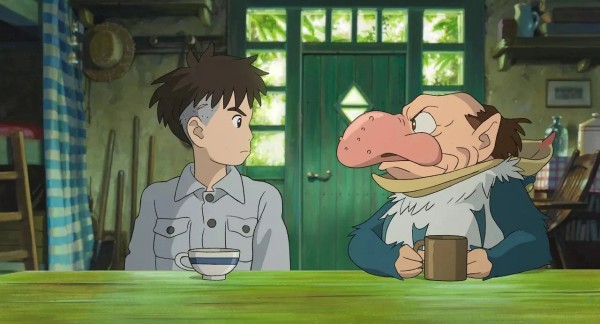 A boy lives through the War in Japan with dreams and games
A boy lives through the War in Japan with dreams and gamesWe all know the master Japanese animator Hayao Miyazaki is 82, long retired but (a decade since
The Wind Rises) back in action, and so "universally loved" his films don't even have to be advertised in Japan. This film is beautiful and engaging - but may be puzzling for the uninitiated. It is set during Wold War II, when Miyazaki was a small boy. He has added years to the age of the protagonist, Mahito, so he is a teenager for the story. Like the filmmaker, evidently, Mahito and his father leave Tokyo and go out into the country - a richly verdant land, limned in gorgeous green pointillist drawing - where the dad works (or officiates) at an airplane factory and Mahito will go to school. His mother has died in a fire. He wanted to save her, and the first vivid sequence of many gorgeous violent yet delicate scenes is of Mahito running frantically toward a great roaring fire, which contains his mother.
It's rather obvious that
The Boy and the Heron is a Miyazakian mélange of fantasy and dream, of creatures that alternate between cuddle and menace. The film's original title means
How Do You Live?, which comes from a a famous 1937 novel by Genzaburo Yoshino (in the film, Mahito finds a copy, dedicated to him by his mother). Yoshino's book, a kind of philosophical coming-of-age tale, is also about a boy, who has lost his father instead of his mother, and is posed questions about life. This film blends its familiar elements with enigmatic pondering, some of it drawn from the book.
Away from Tokyo, out in the country, dream and reality soon blend. Natsuko, Mahito's mother's sister, is with his father now. She looks like his mother but there's a polite distance. In the spirit of those earlier times, everyone bows a lot. Everyone is polite and kind, tea is often prepared and gently poured. There is a gaggle of grannies who look like little gnomes. The seven dwarfs plus two, perhaps. They are helpful and friendly, and talk in a folksy country style. Near the house, a big, comfortable, old fashioned one, where Mahito and his father and Manito are to live now, there is a bigger, pointed, castle-like structure, full of mystery and temptation, which Mahito tries to enter and learn about, but is forbidden to go to by the grannies. Bad spirits dwell there, it seems, and there are rumors of a missing granduncle, who built the castle-tower.
From the moment he arrives at the new house Mahito has a face-off with a big gray heron that is out to get him. Mahito crafts - quite skillfully for a 13-year-old - a bow and arrow, aiming to fire it at the heron. The face-off melds into a conversation, and this "frenamy" relationship persists throughout the film. The heron exemplifies the film's cuddly-menace alternation, because through some kind of trigger he can't altogether control, the gray heron slips from from being a big winged bird to a wing-less, unthreatening ugly-comic gnome-like critter with a big bulbous red nose.
The heron - who talks, by the way - reminds Mahito that he hasn't seen his mother's body, and the boy begins a search for her. The heron also tempts and taunts Mahito to enter the castle. This leads to a search for mysteries and secrets to the universe. But first, there's a brief bout of reality: a country school.
The rustic boys at the school are hostile and rough Mahito up. Then, strangely, he picks up a big rock and gives himself a serious head injury on the way home, to hurt himself much worse than the scuffling boys did. This gets him excused from school, and we see no more of that. The head injury causes a bald sot on one side of Mahito's head which gives his black anime-style spiky boy-hair a stylish look. The bald spot seems also a badge of honor. But why did Mahito injure himself so violently, causing the big red blob of oozing blood? It doesn't look quite real, but it gets him put to bed, tended kindly, and excused from the rough country school. From now on he pursues his own pursuits. A knowledgeable
online commentator calls this "Mahito's cry for help via self-injury."
The film's plot-line is easier to decode when Mahito is carrying his bow and arrow and fighting the heron. But subsequent scenes go in many other directions, and after a while you may get lost. For me this point has been more than reached when a robed philosopher type with long white hair and beard gestures to a pile of multiple-shaped stones and commands Mahito to pile them up in the correct fashion, threatening that the universe will come apart if he doesn't. There is a big dark hairy-looking cloud hovering in the air, and when the stones fall in a jumble, it disintegrates.
Attentive viewers will notice that I haven't mentioned the gang of frogs, warawara or the parakeets, and have left out many interesting incidents. This is because, without prior preparation or cribbing from other writers, it is impossible to make sense of these things.
The elderly Miyazaki has a wonderful tool set to play his games with and his animated images are a delight to the eye. Sometimes it feels as if they may make more sense to him than to us. It was a relief, toward the end of
he Boy and the Heron when suddenly the War was over and Mahito and his father and stepmother return to Tokyo. Mahito is to return to school: but the film ends abruptly there. One couldn't help wishing they'd stayed in Tokyo - or that Mahito hadn't brained himself with the stone but made a go of it with the rustic country schoolboys. At this point, when the screen turns abruptly black, one realizes that apart from the fire that takes away Mahito's mother, which is dreamlike and abstract, we have been led through Japan in World War II without getting a single glimpse of the War - or its aftermath.
The Boy and the Heron 君たちはどう生きるか ("How do you live?"), 124 mins., debuted at TIFF Sept. 7, 2023; many other festivals including New York Oct. 4. It opened in US theaters wider release Dec. 8, 2023. Screened for this review at Cinemark Century Hilltop 16, Richmond, California, Dec. 12, 2023.
Metacritic rating: 92%.






